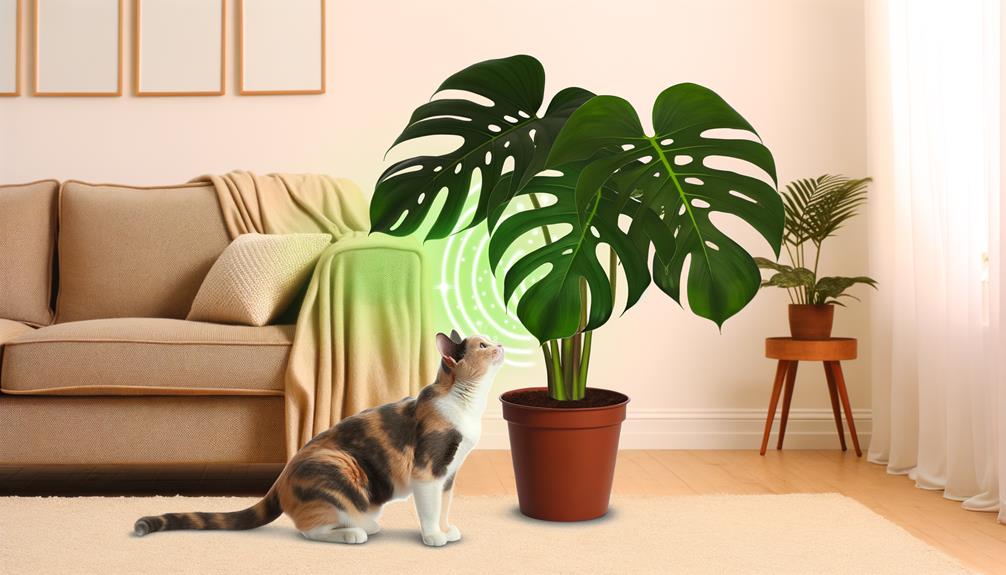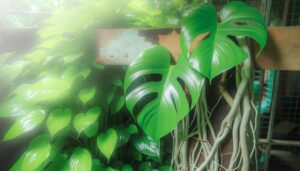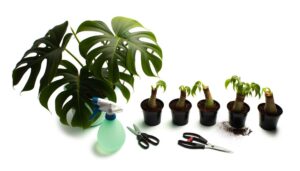Monstera Borsigiana Toxic to Cats
Yes, Monstera Borsigiana is toxic to cats. It contains insoluble calcium oxalates, which are needle-shaped crystals causing oral irritation.
If your cat ingests it, they may experience drooling, mouth swelling, and vomiting. Severity depends on the amount eaten and your cat's sensitivity.
Immediate symptoms suggest inflamed tissues and gastrointestinal upset. Prompt veterinary care is essential, as complications can include difficulty swallowing and infections.
For a safer home environment, consider non-toxic plants like Boston Ferns or Spider Plants. Continue to explore to learn more about keeping your cats safe.

Key Takeaways
- Monstera Borsigiana contains insoluble calcium oxalates harmful to cats.
- Ingestion causes oral irritation, inflammation, and pain in cats.
- Immediate symptoms include drooling, swelling, vomiting, and decreased appetite.
- Prompt veterinary consultation is essential for effective intervention.
- Safe plant alternatives include Boston Ferns, Areca Palms, and Spider Plants.
What Is Monstera Borsigiana?
Monstera Borsigiana, a sought-after variety of Monstera deliciosa, is renowned for its striking foliage and is often desired by plant enthusiasts for its aesthetic appeal. Its leaves are deeply fenestrated, allowing light to filter through, resembling its natural tropical environment.
You can recognize it by its quicker growth rate and smaller leaf size in comparison to Monstera deliciosa. It's a climbing plant, so providing a moss pole or trellis will promote vertical growth. Botanically, Monstera Borsigiana belongs to the Araceae family, known for their distinctive inflorescence and leaf structure.
For best growth, ensure bright, indirect light and well-draining soil. Regular watering, allowing the soil to slightly dry between watering sessions, helps sustain its health and lush appearance.
Toxic Components
However, it's essential to be aware that Monstera Borsigiana contains insoluble calcium oxalates, which are toxic to cats. These needle-shaped crystals, known as raphides, can cause significant irritation upon ingestion.
When chewed or swallowed, the raphides embed themselves in the mucous membranes of the mouth, throat, and gastrointestinal tract. This triggers an inflammatory response and intense pain.
The concentration of calcium oxalates in Monstera Borsigiana is significant enough to pose a risk even with minimal exposure. Research indicates that the plant's toxicity isn't reduced by drying or cooking, maintaining its hazardous nature in all forms.
Understanding the intrinsic toxic components is essential for preventing accidental ingestion and ensuring your cat's safety.
How Cats Are Affected
When cats consume Monstera Borsigiana, they experience immediate symptoms such as drooling, oral pain, and swelling due to the plant's toxic calcium oxalates. These oxalates form needle-like crystals, causing intense irritation upon contact with the oral mucosa.
You'll notice your cat pawing at its mouth or gagging as a reaction to the discomfort. Gastrointestinal upset may follow, leading to vomiting and decreased appetite. The severity of these symptoms varies depending on the amount ingested and the individual cat's sensitivity.
Monitoring for signs of distress is essential, as complications can arise, including difficulty swallowing and secondary infections. Consulting with a veterinarian promptly guarantees appropriate intervention and care, mitigating potential long-term effects on your pet's health.
Symptoms of Poisoning
Upon ingestion, cats exhibit clinical symptoms of Monstera Borsigiana poisoning, including hypersalivation, oral edema, and pronounced gastrointestinal distress.
You may notice your cat drooling excessively, which is a direct reaction to the irritating oxalate crystals in the plant. Oral edema, or swelling of the mouth and tongue, may make it difficult for your cat to eat or drink.
Gastrointestinal distress manifests as vomiting, diarrhea, and abdominal pain, indicating the toxin's systemic impact. Additionally, pawing at the mouth and vocalizing in discomfort are common behavioral signs.
Recognizing these symptoms promptly is essential for timely intervention. Understanding these clinical indicators can help you act swiftly to mitigate the adverse effects of Monstera Borsigiana toxicity on your feline companion.
Immediate Actions to Take
If you notice symptoms like drooling, vomiting, or difficulty swallowing in your cat, it's crucial to act quickly.
Immediately contact your veterinarian to provide details of the ingestion and seek professional advice.
Prompt intervention can greatly mitigate the toxic effects of Monstera Borsigiana.
Identify Ingestion Symptoms
Observing signs of Monstera Borsigiana ingestion in cats requires immediate clinical attention to prevent severe health complications. You must be vigilant in identifying the following symptoms, as they indicate toxic exposure:
- Oral irritation: Look for drooling, pawing at the mouth, and swelling.
- Gastrointestinal distress: Symptoms include vomiting, diarrhea, and decreased appetite.
- Respiratory issues: Watch for labored breathing or wheezing.
- Neurological signs: Tremors, seizures, or disorientation might occur.
These manifestations result from calcium oxalate crystals present in the plant, which cause cellular damage and inflammation. Prompt symptom recognition is essential for initiating timely clinical interventions.
Contact Veterinarian Immediately
Recognizing these symptoms requires contacting your veterinarian immediately to initiate appropriate medical treatment and prevent further complications.
When your cat ingests Monstera Borsigiana, prompt action is vital. Call your vet and describe the symptoms observed, including oral irritation, drooling, vomiting, or difficulty swallowing. Your veterinarian may recommend bringing your cat in for an examination, which could include blood tests and symptom management.
Don't attempt home remedies or induce vomiting without professional guidance, as these actions can worsen the situation. Quick veterinary intervention can greatly improve your cat's prognosis by addressing dehydration, pain, and potential systemic effects.
Trust your veterinarian's expertise to navigate this toxic exposure effectively and ensure your feline friend's swift recovery.
Veterinary Treatments
Veterinary treatments for Monstera Borsigiana toxicity in cats often involve administering activated charcoal to prevent further absorption of toxins in the gastrointestinal tract. Your veterinarian might also perform gastric lavage to clear the stomach contents.
Intravenous fluids are pivotal to maintain hydration and support kidney function. Anti-inflammatory medications help manage pain and reduce swelling from oral irritation.
- Activated Charcoal: Prevents toxin absorption.
- Gastric Lavage: Clears ingested plant material.
- Intravenous Fluids: Maintains hydration and supports kidneys.
- Anti-inflammatory Medications: Reduces pain and swelling.
Prompt veterinary intervention is vital to mitigate the adverse effects of Monstera Borsigiana toxicity. Each treatment is tailored to the severity of the symptoms, ensuring your cat receives the most effective care possible.
Preventing Exposure
To prevent Monstera Borsigiana toxicity in cats, it's imperative to implement strategies that limit their access to this plant. Start by positioning the plant in elevated locations that are out of your cat's reach. Utilize barriers such as shelves or plant stands, ensuring they're stable and inaccessible.
Routinely inspect your home for any fallen leaves or plant debris that may entice your cat. Additionally, consider using aversive agents like bitter sprays on the plant's leaves; these are non-toxic deterrents that discourage chewing. Regularly monitor your cat's behavior and environment, maintaining vigilance for any signs of exposure.
Safe Plant Alternatives
You should consider integrating pet-friendly indoor plants that feature non-toxic foliage into your home environment.
Evidence supports that options like the Spider Plant, Boston Fern, and Areca Palm are safe and hardy varieties for households with cats.
These alternatives not only enhance your living space but also mitigate the risk of toxic exposure.
Pet-Friendly Indoor Plants
Considering the safety of your feline friends, incorporating pet-friendly indoor plants like spider plants, Boston ferns, and areca palms can provide a beautiful yet non-toxic environment. These plants not only enhance your home's aesthetic but also contribute to air purification without posing a risk to your cats.
- Spider Plants (Chlorophytum comosum): Known for their air-purifying qualities and ease of care.
- Boston Ferns (Nephrolepis exaltata): Thrive in humidity and are excellent for hanging baskets.
- Areca Palms (Dypsis lutescens): Add a tropical touch and are effective at removing toxins from the air.
- Calathea (Calathea spp.): Offer vibrant foliage patterns and are safe for pets.
Non-Toxic Foliage Choices
For those seeking additional non-toxic foliage choices, incorporating plants like maranta, baby tears, and friendship plants into your home can enhance safety and aesthetic appeal.
Maranta, commonly known as the prayer plant, exhibits striking leaf patterns and is non-toxic to cats.
Baby tears (Soleirolia soleirolii) offer lush, trailing greenery, and pose no toxicity risk.
Friendship plants (Pilea involucrata), known for their textured leaves, are also safe for feline companions.
These alternatives provide both visual interest and peace of mind.
Evidence-based research validates that these species are non-toxic, ensuring your pets remain unharmed.
Hardy Safe Varieties
Several hardy, non-toxic plant varieties can thrive indoors while ensuring your feline's safety. These alternatives provide aesthetic appeal without compromising your cat's health.
Consider the following options:
- Spider Plant (Chlorophytum comosum): Highly resilient and easy to care for, this plant purifies air and poses no risk to cats.
- Areca Palm (Dypsis lutescens): Known for its feathery fronds, this palm is both pet-safe and effective at improving indoor air quality.
- Boston Fern (Nephrolepis exaltata): This lush fern requires moderate humidity and indirect light, making it a safe, decorative option.
- Parlor Palm (Chamaedorea elegans): Ideal for low-light conditions, this palm is non-toxic and adds a tropical touch to any room.
Choosing these plants helps maintain a cat-friendly environment while enhancing your indoor space.
Monitoring Your Cat
Regularly observing your cat's behavior and physical condition is essential for early detection of any symptoms related to Monstera Borsigiana toxicity. Watch for drooling, pawing at the face, vomiting, or decreased appetite. These symptoms can indicate oral irritation or gastrointestinal distress.
Also, monitor for lethargy or changes in urination, which might imply more severe systemic effects. Conduct a thorough examination of your cat's mouth and throat for signs of swelling, redness, or lesions. Immediate veterinary attention is pivotal if you notice any of these symptoms.
Documentation of any changes, including time and duration, can aid your veterinarian in diagnosing and treating potential toxic exposure. Your vigilance can greatly improve your cat's prognosis and recovery outcomes.
Additional Resources
Frequently, seeking additional resources can provide vital information and support when dealing with Monstera Borsigiana toxicity in cats. Leveraging expert knowledge and evidence-based sources guarantees you're well-equipped to handle this situation.
Here are some valuable options:
- Veterinary Hotlines: Immediate access to professional advice can be essential in emergencies.
- Online Databases: Websites like ASPCA and Pet Poison Helpline offer extensive information on toxic plants.
- Veterinary Clinics: Establishing a relationship with your local vet can provide personalized advice and rapid intervention.
- Support Groups: Online forums and social media communities can offer shared experiences and practical tips.
Using these resources enhances your ability to manage your cat's health effectively, ensuring timely, accurate responses to potential poisoning.
Conclusion
While Monstera borsigiana can add beauty to your home, ensuring your cat's safety is crucial. Don't assume your cat won't be curious; they often nibble on plants.
By being mindful of the symptoms and taking preventive measures, you can safeguard your feline friend. Choose cat-friendly plants and closely observe your pet's behavior.
For more detailed advice, refer to veterinary resources or your local vet. A little attentiveness goes a long way in guaranteeing your cat's well-being.






